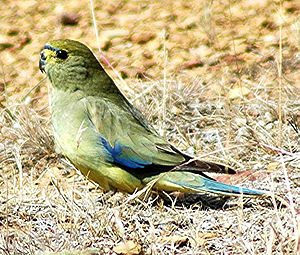Fine parakeet
| Fine parakeet | ||||||||||
|---|---|---|---|---|---|---|---|---|---|---|

Fine parakeet |
||||||||||
| Systematics | ||||||||||
|
||||||||||
| Scientific name | ||||||||||
| Neophema chrysostoma | ||||||||||
| ( Kuhl , 1820) |
The fine parakeet ( Neophema chrysostoma ), also known as the blue-winged parakeet , is a species of parrot that belongs to the tribe of the flat- tailed parakeets . It is very similar in appearance to the African Parakeet , but can be distinguished from it by the extensive dark blue wing markings, the plain dark blue headband and the light green throat and upper chest. The range of the two species overlaps during the winter months.
Appearance
Fine parakeets reach a body length of 21 centimeters and weigh between 33 and 61 grams. The gender dimorphism is not very pronounced.
The males of the parakeets have a bronze-yellow crown and back of the head. The headband is deep blue and extends to the eyes. The reins and around the eyes are yellow. The neck is olive green and tinged with yellow. The front back, the umbrella feathers, as well as the rump and the upper tail covers are of a matt olive green. The cheeks, sides of the neck, throat and chest are light green. The breast becomes more yellowish towards the underbust. The lower half of the underside of the body is bright yellow and can also appear slightly orange on the stomach in individual individuals. The large and small wing covers are bright blue. The bend of the wing and the outer flags of the outer arm covers merge into purple. The wing feathers and the coverts are black-blue, the underside of the tail is yellow. The beak is small and delicate and dark gray. The iris is dark brown.
The females resemble the males. However, the parting and the back of the head are matte olive green. The deep blue headband is not very pronounced in the females. The blue of the wing covers is lighter and plays into the green.
distribution and habitat
The range of the common parakeet extends over the southeast of Australia and Tasmania. Unlike the swallow-tailed parakeet, however, the common parakeet does not breed exclusively in Tasmania and does not return to mainland Australia until autumn. Breeding areas of the parakeet can also be found in Australia south of the 36th parallel south. The winter quarters also include the southwest of Queensland and the northeast of South Australia .
In Tasmania the parakeet is widespread except for the southwest of the island. In the south-west, however, the distribution is patchy. Parakeets also breed on some of the larger islands in the Bass Strait . Only a very small part of the population stays in Tasmania during the winter months. They are then mainly to be found in the interior. Most of the population moves to mainland Australia. Bass Strait is mostly crossed during the night.
Fine parakeets are only slightly specialized grass parakeets, which prefer to use tree savannahs, but can also be found in open grasslands, shrub savannas, heather shrub formations, cleared areas as well as on orchards, in grain-growing areas and forest clearings. You can also be found in Tasmania in the coastal hinterland.
behavior
During the breeding season, parakeets live in pairs or in small schools with up to twenty individuals. There are larger swarms outside of the breeding season. Fine Parakeets are then sometimes with jewelry parakeets and Orange-bellied Parrots socialized. They look for food primarily in the early morning and late afternoon. They mainly feed on the seeds of grass and herbaceous plants. Their food spectrum also includes flowers, berries, fruits as well as insects and their larvae. Most of the food intake takes place on the ground. During the hottest part of the day, they take shelter in trees and shrubs.
Fine parakeets are cave breeders who prefer to use tree hollows in tall eucalyptus trees. They breed from the end of October. The young birds leave the nest box at the end of February. The clutch consists of four to six eggs. These lie on a layer of rotting wooden mulms on the cave floor. It only breeds the female. The incubation period is 20 days. During the breeding season, the male feeds the female.
supporting documents
Individual evidence
- ^ Forshaw, pp. 572 and 574
- ^ Forshaw, p. 574
- ^ Forshaw, p. 576
- ^ Forshaw, p. 577
- ^ Forshaw, p. 575
- ^ Forshaw, p. 577
- ^ Forshaw, p. 576
- ^ Forshaw, p. 578
literature
- Joseph M. Forshaw : Australian Parrots. 1st German-language edition. Volume 2, Arndt-Verlag, Bretten 2003, ISBN 3-9808245-2-7 .
Web links
- Neophema chrysostoma inthe IUCN Red List of Endangered Species 2013.1. Listed by: BirdLife International, 2012. Retrieved September 28, 2013.